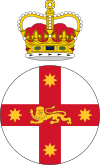Lieutenant-Governor of New South Wales facts for kids
Quick facts for kids Lieutenant-Governor of New South Wales |
|
|---|---|

Badge of the Governor of New South Wales
|
|
|
Incumbent
Andrew Bell since 5 December 2022 |
|
| Office of the Governor Executive Council of New South Wales |
|
| Style | His Excellency The Honourable |
| Member of | Supreme Court of New South Wales |
| Nominator | Premier of New South Wales |
| Appointer | King of Australia in right of the State of New South Wales |
| Term length | At His Majesty's pleasure |
| Website | Office of the Governor |
The lieutenant-governor of New South Wales is an important government job in the Australian state of New South Wales, Australia. This person acts as a helper or deputy to the governor of New South Wales.
The job was first created way back in October 1786. This was even before the first ships, known as the First Fleet, arrived in Australia. The first lieutenant-governor was meant to help the very first governor, Arthur Phillip.
In the early days, the lieutenant-governor was usually a military officer. This position was only filled when it was really needed, like when the governor was away for a long time.
Since 1872, the person holding this job has also been the chief justice of New South Wales. This means the top judge in the state also takes on this role. Sometimes, they can even keep the lieutenant-governor title after they retire from being a judge.
What the Lieutenant-Governor Does
At first, the lieutenant-governor had a role in making laws. They were part of the first Legislative Council of New South Wales in 1824. But over time, the state governor's powers changed, and this law-making role was removed.
Today, the main job of the lieutenant-governor is to step in for the governor. They take over if the governor dies, resigns, or is away from New South Wales. The rules for this job are written in the New South Wales Constitution Act (1902).
The lieutenant-governor doesn't usually have their own powers. But they hold a special "dormant commission." This means they have the authority ready to use if they need to act as governor.
For example, in September 2008, Governor Marie Bashir was away. So, the Lieutenant-Governor, James Spigelman, stepped in. He officially swore in the new government cabinet led by Nathan Rees.
If both the governor and the lieutenant-governor are unavailable, another person steps in. This person is called the administrator. It's usually the next most senior judge from the Supreme Court.
This happened in May 1973. Governor Sir Roden Cutler was overseas when Sir Leslie Herron (the lieutenant-governor) suddenly died. So, Sir John Kerr became the administrator until Governor Cutler could return.
Past Lieutenant-Governors and Administrators of NSW
Here is a list of people who have served as lieutenant-governors or administrators in New South Wales:
| Name | Term start | Term end | Notes | |||||
|---|---|---|---|---|---|---|---|---|
| Major Robert Ross | 7 February 1788 | 8 July 1792 | ||||||
| Major Francis Grose | 11 December 1792 | 12 December 1794 | ||||||
| Lieutenant-Colonel William Paterson | 13 December 1794 | 1 September 1795 | ||||||
| Office vacant | 20 September 1795 | 24 March 1806 | ||||||
| Colonel William Paterson | 24 March 1806 | 26 January 1808 | ||||||
| Major George Johnston | 26 January 1808 | 25 April 1808 | ||||||
| Lieutenant-Colonel Joseph Foveaux | 25 April 1808 | 9 January 1809 | ||||||
| Lieutenant-Colonel Sir Maurice O'Connell | 10 January 1810 | 12 February 1814 | ||||||
| Colonel George Molle | 13 February 1814 | 12 September 1817 | ||||||
| Colonel James Erskine | 12 September 1817 | 25 February 1823 | ||||||
| Colonel William Stewart | 26 February 1823 | 23 March 1827 | ||||||
| Office vacant | 24 March 1827 | 4 December 1837 | ||||||
| Colonel Patrick Lindesay | 22 October 1831 | 2 December 1831 | ||||||
| Lieutenant-Colonel Kenneth Snodgrass | 5 December 1837 | 23 February 1838 | ||||||
| Office vacant | 24 February 1838 | 12 July 1846 | ||||||
| Sir Maurice O'Connell | 12 July 1846 | 2 August 1846 | ||||||
| Office vacant | 2 August 1846 | 21 January 1861 | ||||||
| Lieutenant-Colonel John Francis Kempt | 22 January 1861 | 21 March 1861 | ||||||
| Office vacant | 22 March 1861 | 21 May 1867 | ||||||
| Major-General Sir Trevor Chute | December 1867 | January 1868 | ||||||
| Office vacant | 1868 | 21 February 1872 | ||||||
| Lieutenant-Governors who were also the Chief Justice | ||||||||
| Sir Alfred Stephen | 22 February 1872 | 26 November 1891 | ||||||
| Sir Frederick Darley | 26 November 1891 | 30 March 1910 | ||||||
| George Bowen Simpson | 24 March 1909 | 27 January 1910 | ||||||
| Sir William Cullen | 30 March 1910 | 1 October 1930 | ||||||
| Sir Philip Street | 1 October 1930 | 17 October 1938 | ||||||
| Sir Frederick Jordan | 17 October 1938 | 4 November 1949 | ||||||
| Sir Kenneth Street | 27 February 1950 | 22 April 1972 | ||||||
| Sir Leslie Herron | 22 April 1972 | 3 May 1973 | ||||||
| Sir John Kerr | 30 August 1973 | 1 July 1974 | ||||||
| Sir Laurence Street | 1 July 1974 | 24 July 1989 | ||||||
| Anthony Murray Gleeson | 24 July 1989 | 18 June 1998 | ||||||
| James Spigelman | 18 June 1998 | 1 February 2012 | ||||||
| Tom Bathurst | 1 February 2012 | 5 December 2022 | ||||||
| Andrew Bell | 5 December 2022 | present | ||||||

